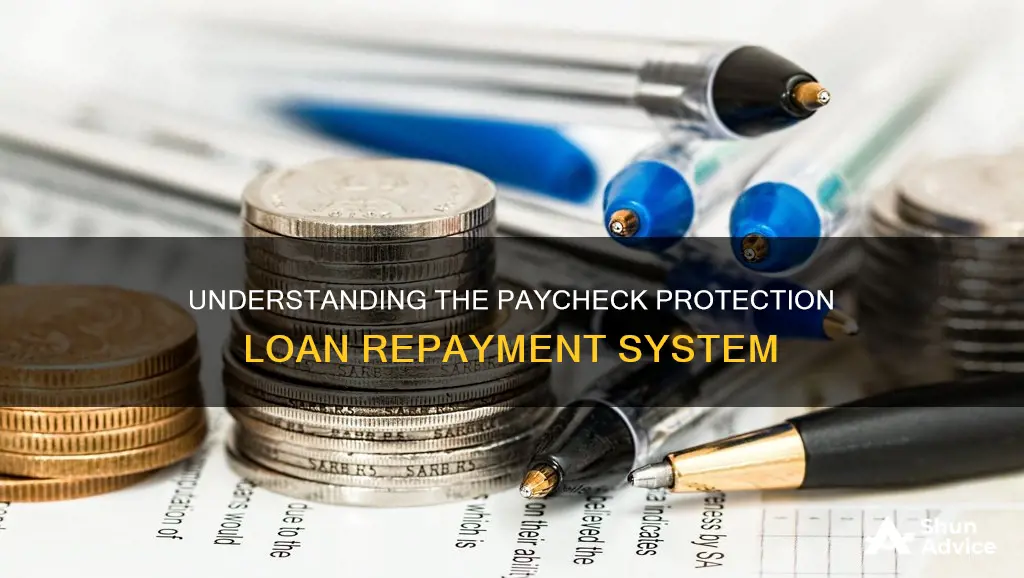
The Paycheck Protection Program (PPP) was a federal relief program that provided small businesses with forgivable loans to retain employees during the COVID-19 crisis. While most PPP loans have been forgiven, some companies are voluntarily repaying their loans even when they don't have to. This raises the question: does a paycheck protection loan have to be paid back? The answer depends on various factors, including eligibility, loan usage, and potential fraud. Understanding the conditions under which these loans are forgiven or repaid is essential for borrowers and policymakers alike.
| Characteristics | Values |
|---|---|
| Loan Forgiveness Criteria | 100% of the loan will be forgiven if used for payroll costs, mortgage interest, rent, or utility payments over 8 weeks after receiving the loan proceeds. Businesses must keep workers on their payroll for an 8-week period after the loan is granted. |
| Interest Rate | 1% |
| Collateral or Guarantor | Not required |
| Maturity Period | 2 years |
| Prepayment Penalties | None |
| Deferral Period | 6 months |
| Maximum Loan Amount | $10 million |
| Applicant Eligibility | Small businesses with 500 or fewer employees. Sole proprietors and independent contractors are eligible for their own loans. Nonprofits, veterans organizations, and tribal businesses are also eligible. |
| Application Process | SBA 7(a) loan application process. Completed SBA Paycheck Protection Program Application Form (SBA Form 2483). Articles of Incorporation/Organization. Bylaws/Operating Agreement. All owners' driver's licenses. Certification Form. Payroll expense verification documents. |
| Non-Eligibility | Businesses that have obtained a direct or guaranteed loan from SBA or any Federal agency with a delinquent status or default in the last 7 years. Businesses with an owner who is incarcerated, on probation, on parole, indicted, or convicted of a felony within the last 5 years. |
| Fraudulent Applications | Punishable by imprisonment of up to 5 years and/or a fine of up to $250,000 under 18 USC 1001 and 3571. |
What You'll Learn

Forgiveness criteria
The Paycheck Protection Program (PPP) is a government initiative to help small businesses stay afloat and keep employees in their jobs during the economic uncertainty caused by the COVID-19 pandemic. The program is part of the Coronavirus Aid, Relief, and Economic Security (CARES) Act.
The PPP loans are intended to be used primarily for payroll costs, and businesses must meet certain criteria to be eligible for loan forgiveness. The criteria include:
- Keeping employees on payroll and maintaining their salaries
- Using at least 60% of the loan amount for eligible payroll costs
- Using the remaining funds (up to 40% of the loan amount) for eligible non-payroll costs, such as business mortgage interest payments, business rent, utilities, and other covered expenditures as defined by the SBA
- Not reducing the number of full-time employees during the loan period
- Not reducing the salary or wages of any employee earning less than $100,000 annually by more than 25%
- Spending the loan funds during the first eight weeks after obtaining the loan
- Providing documentation to support the eligible costs, such as payroll tax filings, bank account statements, invoices, and receipts
It is important to note that businesses must use the loan funds for their intended purposes and provide proper documentation to be eligible for loan forgiveness. Failure to do so may result in fraud charges and repayment obligations.
Stimulus Package: EIDL Loans Included or Excluded?
You may want to see also

Loan maturity
The Paycheck Protection Program (PPP) was introduced to provide federally-guaranteed loans to eligible small businesses to help them retain employees throughout and after the Coronavirus (COVID-19) crisis. The program was established under the CARES Act (Coronavirus Aid, Relief, and Economic Security Act), which approved $350 billion in funds to be offered to small businesses to help meet payroll and other expenses.
The PPP loans have a maturity of two years and a 1% interest rate. Loan payments are deferred for six months, during which interest will accrue. The program is designed to give businesses extra time and financial support to recover.
Loans granted under the PPP will be forgiven if certain requirements are met. Businesses must spend at least 60% of the loan on payroll and retain their employees for eight weeks after the loan is granted. The funds can also be used for mortgage interest, rent, and utility payments. If a business fails to meet these requirements, the loan must be repaid.
Some companies have voluntarily repaid their PPP loans, even when eligible for forgiveness. This may be due to ethical considerations, a failure to meet forgiveness criteria, or a belief that repaying would be easier than applying for forgiveness.
Borrowers can apply for loan forgiveness any time before the maturity date of the loan, which is typically two years from the origination date but can be up to five years in certain cases.
Military Loan Forgiveness: College Dreams, Reality?
You may want to see also

Payroll costs
The Paycheck Protection Program (PPP) was established under the Coronavirus Aid, Relief, and Economic Security (CARES) Act to provide loans to small businesses to cover payroll and other expenses. The program offers loans of up to $10 million, with a maturity of two years and a fixed interest rate of 1%. The maximum loan amount is calculated as 2.5 times the average monthly payroll costs for the previous calendar year.
To be eligible for loan forgiveness, businesses must use the funds during the eight-week period after receiving the loan. This period can be extended for payroll costs incurred but not paid during the last pay period of the eight weeks if they are paid on or before the next regular payroll date. Businesses must also maintain staffing levels and limit salary reductions to no more than 25% during this time.
It is important to note that sole proprietors and independent contractors are not included in payroll costs as they can apply for their own PPP loans. Additionally, employees must have their principal place of residence in the United States to qualify for payroll costs. Businesses are required to verify their information and retain payroll records for four years to support their loan application and forgiveness process.
Missing Documents: Nelnet Loans and National Collegiate's Impact
You may want to see also

Loan eligibility
The Paycheck Protection Program (PPP) was introduced as part of the Coronavirus Aid, Relief, and Economic Security (CARES) Act to provide forgivable loans to small businesses. The program is designed to help employers meet payroll and other expenses, with a particular focus on supporting businesses unable to access loans elsewhere.
To be eligible for a PPP loan, businesses must meet specific criteria. Initially, eligibility was limited to self-employed individuals and businesses with fewer than 500 employees, with a cap of 100 employees for subsequent PPP loans. Additionally, businesses must demonstrate a significant decrease in revenue, typically more than 50% compared to the previous quarter or the same period in the previous year. This requirement ensures that the loans are targeted towards businesses genuinely impacted by the pandemic.
The eligibility criteria also consider the type of business applying for the loan. Publicly traded companies, for example, are generally not eligible for a second PPP loan. Businesses with multiple locations in the hospitality and lodging industries have a loan limit of $2 million across all locations. The eligibility criteria also extend to the intended use of the loan. PPP loans are specifically designed to support payroll and rent or mortgage payments. While this program initially required at least 75% of the loan amount to be allocated to payroll costs, subsequent adjustments allowed for more flexibility in using the funds for other operating expenses, such as business software, delivery services, and human resources.
It is important to note that PPP loans are not solely for businesses. Self-employed individuals, sole proprietors, and independent contractors are also eligible to apply for their own loans. This provision ensures that a diverse range of workers affected by the pandemic can access financial support.
Loan Forgiveness
While PPP loans are technically loans, they often function more like grants, as they can be forgiven under certain circumstances. To have their loan forgiven, businesses must meet specific criteria, such as spending at least 60% of the loan on payroll within a specified timeframe. Borrowers can apply for loan forgiveness at any time before the maturity date of the loan, which is typically two years from the loan's origination.
In conclusion, the PPP loan program offers financial support to eligible small businesses and self-employed individuals impacted by the pandemic. By understanding the eligibility criteria and loan forgiveness conditions, businesses can effectively access and utilize these funds to navigate economic challenges.

Fraud
The Paycheck Protection Program (PPP) was designed to soften the financial impact of the pandemic on small businesses. It issued about $800 billion in potentially forgivable government loans to keep workers employed during COVID shutdowns. However, the program has been criticized for its lack of scrutiny in the loan forgiveness process, with the SBA's inspector general stating that it enabled an "unprecedented level of fraud activity".
Indeed, there have been reports of fraud and scams targeting businesses that received PPP loans. One common scam involves impersonation or employee misclassification fraud, where cybercriminals hack employee records or access company portals using phished credentials to create a false identity. They then redirect paychecks into a criminal-controlled account. Another scam involves receiving a fake check for an excess amount and then being asked to wire back the remainder.
To prevent fraud, businesses should tighten scrutiny over direct deposit changes and systems access, use multi-factor authentication for sensitive employee records, and increase employee education on potential red flags. Additionally, businesses should be cautious of suspicious communication claiming to be from financial institutions and should report any suspected fraud to their financial institution and the Federal Trade Commission.
Furthermore, individuals should also be aware of potential scams, such as offers that seem too good to be true or requests for payments through unsecured methods. It is important to only send money to trusted individuals and to confirm recipient contact information. If you suspect a scam, it is advisable to contact the relevant financial institution and refer to the user service agreement to understand your rights and protections.
PPP loan fraud can also occur if funds are knowingly used incorrectly. In such cases, borrowers could be charged with fraud and may be asked to repay the loan.
Frequently asked questions
The Paycheck Protection Program (PPP) loan is intended to be forgiven, meaning you don't have to pay it back. However, there are certain requirements that must be met for the loan to be forgiven. If these requirements are not met, the loan may have to be repaid.
The primary requirement for PPP loan forgiveness is that the loan must be used for specified expenses over an 8-week period after receiving the loan. These expenses include payroll costs, mortgage interest, rent, and utility payments. Additionally, companies must keep their workers on the payroll for this 8-week period and cannot reduce salaries for employees earning less than $100,000 annually by more than 25%.
If you don't meet the requirements for PPP loan forgiveness, you may have to repay the loan. It is important to note that borrowers can apply for forgiveness any time before the maturity date of the loan, which is typically 2 years from when the loan was originated. In some cases, businesses may choose to voluntarily repay their loans even if they meet the requirements for forgiveness.







